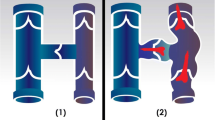Abstract
Varicose veins (VVs) are dilated, enlarged, and tortuous superficial veins that most commonly occur in the lower extremities. Lower-extremity VVs result from intravenous reflux of blood, in turn due to vein wall dilatation and valvular incompetence of superficial veins. The VVs are classified as per CEAP classification. It is important to find the anatomical extent and etiology-pathophysiology of VVs. A set of investigations are required to exactly know the type of VVs. It is especially important to know which system, superficial, deep, or perforators, is involved. Though color duplex scanning is the gold standard for the diagnosis of VVs, sometimes, other investigations come into play for arriving at a diagnosis especially if the deep venous system is involved and in cases of recurrent disease. This paper discusses the systematic investigational plan for the diagnosis of the VVs in suspected cases.






Similar content being viewed by others
References
Bergan JJ, Schmid-Schönbein GW, Smith PD, Nicolaides AN, Boisseau MR, Eklof B (2006) Chronic venous disease. N Engl J Med 355:488–498
Raju S, Neglén P (2009) Clinical practice. Chronic venous insufficiency and varicose veins. N Engl J Med 360:2319–2327
Kostas TI, Ioannou CV, Drygiannakis I, Georgakarakos E, Kounos C, Tsetis D, Katsamouris AN (2010) Chronic venous disease progression and modification of predisposing factors. J Vasc Surg 51:900–907
Sritharan K, Lane TR, Davies AH (2012) The burden of depression in patients with symptomatic varicose veins. Eur J VascEndovasc Surg 43:480–484
Souza Nogueira G, Rodrigues Zanin C, Miyazaki MCOS, Pereira de Godoy JM (2009) Venous leg ulcers and emotional consequences. Int J Low Extrem Wounds 8(4):194–196
Vikas AM, Rishit H, Akhilesh S (2015) Vitamin B12 and vitamin D deficiencies: an unusual cause of fever, severe hemolytic anemia and thrombocytopenia. J Family Med Prim Care. 4:145–148
. Varghese R, Patel M, Rajarshi M. (2019) Role of vitamin D3 in the management of pain in c5- 6 chronic venous disease (CVD): need to include as an Integral Part in the treatment protocol. Abstract published in the Hungarian Journal of Vascular diseases XXVI, 2019/3 page 17. Presented at conference “Another Phlebology” held on 4–5 October 2019, Hungary
Campbell WB, Niblett G, Peters AS et al (2005) Clinical effectiveness of hand held Doppler examination for diagnosis of reflux in patients with varicose veins. Eur J Vasc Endovasc Surg 30:664–669
Necas M (2010) Duplex ultrasound in the assessment of lower extremity venous insufficiency. Australas J Ultrasound Med 13:37–45
Pichot O, Menez C (2016) Role of duplex ultrasound investigation in the management of postthrombotic syndrome. Phlebolymphology 23:102–111
Yan Y, John S, Ghalehnovi M et al (2019) Photoacoustic imaging for image-guided endovenous laser ablation procedures. Sci Rep 9:2933. https://doi.org/10.1038/s41598-018-37588-2
Lockhart ME, Sheldon HI, Robbin ML (2005) Augmentation in lower extremity sonography for the detection of deep venous thrombosis. AJR Am J Roentgenol 184:419–422
Sutter ME, Tumipseed SD, Diercks DB et al (2009) Venous ultrasound testing for suspected thrombosis: Incidence of significant non-thrombotic findings. J Emerg Med 36:55–59
Coleridge- Smith P, Labropoulos N, Partsch H, Myers K, Nicolaides A, Cavezzi A (2006) Duplex ultrasound investigation of the veins in chronic venous disease of the lower limbs – UIP consensus document. Part I. Basic Principles. Eur J Vasc Endovasc Surg 31:83–92
Fraser JD, Anderson DR (1999) Deep venous thrombosis: recent advances and optimal investigation with US. Radiology 211:9–24
Rosen MP, McArdle C (1997) Controversies in the use of lower extremity sonography in the diagnosis of acute venous thrombosis and a proposal for a unified approach. Semin US CT MRI 18:362–368
Johnson SA, Stevens SM, Woller SC et al (2010) Risk of deep vein thrombosis following a single negative whole-leg compression ultrasound: a systematic review and meta-analysis. JAMA. 303:438
Evans CH, Allan PL, Lee AJ, Bradbury AW, Fowkes RCV, GR. (1998) Prevalence of venous reflux in the general population on duplex scanning: The Edinburgh Vein Study. J Vasc Surg 28:767–776
Bays RA, Healy DA, Atnip RG, Neumyer M, Thiele BL (1994) Validation of air plethysmography, photoplethysmography and duplex ultrasonography in the evaluation of severe venous stasis. J Vas Surg 20:721–727
Baldt MM, Zontsich T, Stümpflen A, Fleischmann D, Schneider B, Minar E, Mostbeck GH (1996) Deep venous thrombosis of the lower extremity: efficacy of spiral CT venography compared with conventional venography in diagnosis. Radiology 200:423–428
Stein Paul D, Matta Fadi, Yaekoub Abdo Y, Kazerooni Ella A, Jennifer Ellis Cahill, Goodman Lawrence R, Dirk Sostman H, Hales Charles A, Denier James E, Weg John G, Ghumman Dilraj, Chan Kevin M, Woodard Pamela K, Kwun Yoojin (2010) CT venous phase venography with 64-detector CT angiography in the diagnosis of acute pulmonary embolism. Clin Appl Thromb/Hemost 16:422–429
Tamura K, Nakahara H (2014) MR venography for the assessment of deep vein thrombosis in lower extremities varicose veins. Ann Vasc Dis 7(4):399–403
Yock P, Fitzgerald P, Popp R et al (1995) Intravascular ultrasound. Sci Am Science Med 2:68
Raju Seshadri, Knepper Jordan, May Corbin, Knight Alexander, Pace Nicholas, Jayaraj Arjun, Miss Jackson (2019) J Vas Surg: Venous Lym Dis 7:428–40
Khanna AK, Singh S, Tiwary SK, Khanna S, Deshpandey S, Shukla RC, Kumar P (2020) (2020) Ambulatory venous pressure studies and its correlation with ceAP grading of varicose veins. Acta Phlebol 21:16–22
Eklof B, Rutherford RR, Berghan J et al (2004) Revision of the CEAP classification for chronic venous disorders: consensus statement. J Vas Surg 40:1248–1252
Author information
Authors and Affiliations
Corresponding author
Ethics declarations
Conflict of Interest
The authors declare no competing interests.
Additional information
Publisher's Note
Springer Nature remains neutral with regard to jurisdictional claims in published maps and institutional affiliations.
Rights and permissions
About this article
Cite this article
Varghese, R., Patel, M., Rajarshi, M. et al. Varicose Veins—How to Investigate. Indian J Surg 85 (Suppl 1), 15–21 (2023). https://doi.org/10.1007/s12262-021-03093-6
Received:
Accepted:
Published:
Issue Date:
DOI: https://doi.org/10.1007/s12262-021-03093-6




